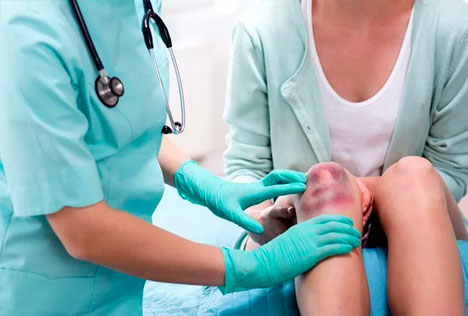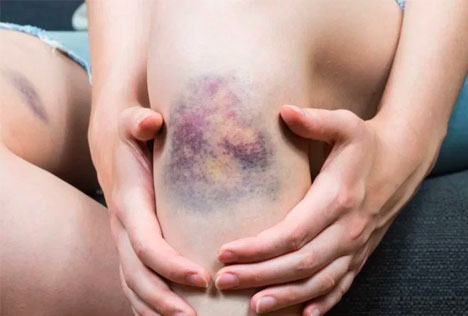Bruise Treatment

A bruise forms when a soft tissue injury occurs, breaking the veins and capillaries under the skin. Red blood cells pour out of the broken vessels and collect under your skin, which causes discolored markings. Some people are prone to bruises, whereas others have stronger skin tissue.
Since you have veins and capillaries throughout your body, bruises can form anywhere. Your Manhattan dermatologist regularly sees bruising. Common places for bruises include your:
- Tailbone (known as the coccyx)
- Knees
- Ribs
- Legs
And your NYC dermatologist has extensive experience in treatment for bruised tailbones, bruised knee treatment, bruised ribs treatment, and bone bruise treatment. Serious bruises require medical attention and treatments. Recovery, risks, and side effects depend on a range of issues, from your general health to your age and how extensive the damage is.
Main Characteristics of a Bruised Tailbone
A tailbone injury may be responsible for pain and discomfort in the lower back area of your body. A visual sign includes the bruising and discoloration of your skin in the area. Nonvisual symptoms include tenderness, pain, and strained bowel movements.
Most coccyx injuries occur in women because they have broader pelvises, leaving the tailbone more exposed and prone to injury. Causes of a tailbone injury include:
- A fall onto a hard surface
- A direct hit (usually during a contact sport)
 Contact your doctor if you experience any of the visual or physical symptoms of a coccyx injury. Your NYC dermatologist only gets involved only if your skin seems permanently discolored or you’re left with an unsightly scar.
Contact your doctor if you experience any of the visual or physical symptoms of a coccyx injury. Your NYC dermatologist only gets involved only if your skin seems permanently discolored or you’re left with an unsightly scar.
Treatment for Bruised Tailbones
If you only have minor discomfort and little to no signs of bruising after a fall on your rear end, you can rely on at-home treatment for bruised tailbones. Treatments to lessen the pain of a bruised tailbone include:
- Lean forward while sitting down
- Sit with a wedged cushion or pillow under you
- Alternate putting heat and ice on the location
- Take over-the-counter pain relievers
Visit your doctor to make sure you haven’t done more damage than you realize. In serious cases, your doctor may order tests to determine the extent of the injury before putting a treatment plan together. For more serious injuries, treatment for bruised tailbones may involve physical therapy, massages, injected medication, or surgery.
Bruised Knees
A bruised knee is a result of an impact on the knee. Pain and discoloration occur in the patella or kneecap when you bruise your knee. Some common ways of injuring your knee are:
- Falling onto a hard surface directly on your knee
- A contusion from something like a ball hitting your knee while playing a sport
Symptoms of a bruised knee include pain on immediate impact or soft tissue damage, such as a sprain or strain. Swelling can also occur, as well as pain while walking. Whenever you experience skin discoloration, visit a Manhattan dermatologist. The severity of the injury determines the bruised knee treatment you require. An X-ray can tell if your knee is merely bruised or if the injury is more serious.
Bruised Knee Treatment
Bruised knee treatments range from ice packs to surgery, all depending on the severity of the injury. Check with your doctor about limitations and treatments. Possible treatment options for a knee contusion include:
- Icing your injured knee every three to four hours for 20 minutes each time until swelling and pain decreases
- Propping your knee up while sitting or lying down
Furthermore, finding some safe stretches to supplement your bruise knee treatment can aid in a faster recovery. Be sure to check with your doctor to learn what activities you can participate in and how long the healing process is going to take.
Bruised Ribs Can Feel Painful
Bruising your ribs often results from an impact on the chest. The most common way to injure your ribs is during a contact sport. Bruised ribs treatment rarely involves more than just leaving them alone to heal on their own. But seek medical assistance or advice if your injury doesn’t improve or if it gets worse.
You’ll know you have a bruised rib if you feel pain in your chest area when breathing or coughing. The skin may discolor, and some bruising or swelling may occur. The healing process for bruised ribs takes about two to four weeks.
Bruised Ribs Treatment
The best thing to do for yourself while recovering from a bruised rib is to breathe normally to help clear out any mucus from your lungs. Proper breathing can also prevent a chest infection. Your doctor may prescribe painkillers to ease your discomfort. Other options include:
- Icing to reduce pain and swelling
- Resting, walking, and moving your shoulders to help to breathe
- Avoiding laying down or staying still for long periods
- Breathing exercises
- Not lifting heavy objects
You may have to take time off work if your job requires excessive physical labor. If you feel the need to cough, clutching a pillow to your chest helps to lessen the pain.
Other Bone Bruises
A bone bruise is less severe than a fracture; however, it’s still a traumatic injury. The bruising causes blood and fluid to build up in and around the bone. Most bone bruises take approximately one to two months to heal completely.
Some symptoms of a bone bruise include pain, swelling, and bruising at the spot of the injury. After the injury, it’s recommended that you not participate in contact sports or work that requires extensive labor. Bone bruise treatment is best decided by your doctor, but some home remedies that work include:
- Lots of rest
- Icing the area for 10 to 20 minutes a few times per day
- Pain relievers such as ibuprofen
- Elevating your leg or foot if that’s where the bruise is
- Massaging the injured area to encourage blood flow
If your symptoms progress, you may need an MRI. Contact your doctor or seek medical attention if your pain gets worse.
Important Reminder: This information is only intended to provide guidance, not definitive medical advice. Please consult dermatologist NYC about your specific condition. Only a trained, experienced board certified dermatology doctor or pediatric dermatologist could determine an accurate diagnosis and proper treatment.
Locations: Manhattan Dermatology (Upper East Side) 983 Park Ave, Ste 1D1, NY 10028(212) 427-8750 Manhattan Dermatology (Midtown) 56 W 45th St, Ste 819, NY 10036
(212) 889-2402 Manhattan Dermatology (Union Square) 55 W 17th St, Ste 103, NY 10011
(212) 378-9984

